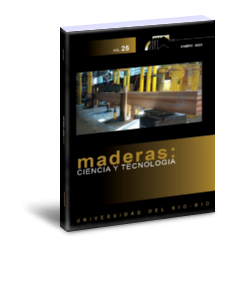Estimation of above ground biomass and carbon of Pinus caribea in bulolo forest plantation, Papua New Guinea
DOI:
https://doi.org/10.4067/s0718-221x2023000100409Keywords:
Allometry models, biomass volume, carbon sequestration, carbon stock, climate change mitigation process, planted forestAbstract
Planted forest plays vital role in tree biomass which stored as carbon through carbon sequestration process and help reduce global warming and climate change effect. Estimation of biomass volume is the important process to determine the carbon contents stored in planted forest trees. Study was conducted to estimate the biomass and carbon content of Pinus caribea trees using allometry models at Bulolo forest plantation in Morobe Province of Papua New Guinea. Study involves center plot of the cluster design in order to collect field data as sample size The field data was collected by measuring stem of Pinus caribea tree species using two variables, diameter at breast height (DBH) and height. Finding reveals that first and highest rank biomass stem content and carbon stocking was 472,4 biomass/ha, followed by 407,076 biomass/ha and the least was 320,97 biomass/ha. Study reveals that biomass stem content and carbon stocking with 407,076 biomass/ha was the more suitable and applicable model for calculation of Pinus caribea in Bulolo forest plantation. Study recommends the log formula derived from the biomass stem content and carbon stocking of 407,076 biomass/ha, as the reliable model to be used for estimation of biomass content and carbon stock of Pinus caribea tree species Bulolo forest plantation and else way in Papua New Guinea.
Downloads
References
Coutinho, M.V.; Sanquetta, R.C.; Bittencourt, A.P.; da Silva, F.S.; Proceke, H.H.; Moreau, J. 2018. Simultaneous Equations to Estimate Above ground Biomassof Pinus caribaea var. hondurensis. Floram 25(3): 1-10. https://doi.org/10.1590/2179-8087.045216
Curtis, R.O.; Bruce, D.; VanCoevering, C. 1968. Volume and Taper Tables for Red Alder. Pacific Northwest Forest and Range Experiment Station, Portland, United States. https://www.fs.fed.us/pnw/pubs/pnw_rp056.pdf
Adams, E.E. 2012. EP1-C56: Earth Policy Institute, Washington D.C, United States. http://www.earth-policy.org/indicators/C56
Greaves, E.D.; Marin, Y.; Visaez, F.; Hernández, J.V. 2015. Forestry plantations of Pinus caribaea in Venezuela as a solar energy collector. Interciencia 40(7): 458-464. https://www.redalyc.org/pdf/339/33940000004.pdf
Karmar, M.; Damba, P.; Pilisi, A.; Malabuo, E.; Jenkiau, A. 2013. Volume Table of Pinus caribea in Bulolo/Wau Plantation of Papua New Guinea. 7th Huon Seminar: Achieving Vision 2050 through Higher Education, Research, Science and Technology. November 13th to 14th 2013, Papua New Guinea University of Technology, Lae, Papua New Guinea. https://documents.pub/document/volume-table-for-pinus-caribaea-in-bulolo-wau-forest-since-2003-the-company.html
Lamb, A.F.A. 1973. Pinus caribaea:Fast growing timber trees of the lowland tropics. Commonwealth Forestry Institute 1(6): 204-205. https://academic.oup.com/forestry/article-pdf/47/2/204/6743188/47-2-204.pdf
Ostadhashemi, R.; Shahraji, R.T.; Roehle, H.; Limaei, M.S. 2014. Estimation of biomass and carbon storage of tree plantations in northern Iran. J For Sci 60(9): 363–371. http://dx.doi.org/10.17221/55/2014-JFS
Papua New Guinea National Planning. 2010. PNGNP-2010: Medium Term Development Startegies - 2010 - 2030. Port Moresby, National Capital District, Papua New Guinea. https://png-data.sprep.org/dataset/png-development-strategic-plan-2010-2030
Rojas-García, F.; De Jong, J.H.B.; Martínez-Zurimendí, P.; Paz-Pellat, F. 2015. Database of 478 allometric equations to estimatebiomass for Mexican trees and forests. Annal For Sci 72(6): 835 - 864. http://dx.doi.org/10.1007/s13595-015-0456-y
Subasinghe, U.; Harpriya, R.M.A. 2014. Prediction of Stem Biomass of Pinus caribaea Growing in the Low Country Wet Zone of Sri Lanka. J Trop For Environ 4(1): 40-49. http://dx.doi.org/10.13140/2.1.4645.6967
Timber Trade Portal. 2016. TTP-2016: Forest Resources and Context of Papua New Guinea, Timber Trade Portal. https://www.timbertradeportal.com/en/papua-new-guinea/90/country-context
Yati, B.; King, T.; Shearman, P. 2004. China's Impact on Papua New Guinea's Forest Industries. Forest Trends, Papua New Guinea. https://www.cifor.org/publications/pdf_files/research/governance/attachment4.pdf
Zell, J.; Bösch, B.; Kändler, G. 2014. Estimating above-ground biomass of trees: Comparing Bayesian calibration with regression technique. Eur J For Res 133(4): 649-660. http://dx.doi.org/10.1007/s10342-014-0793-7
Downloads
Published
How to Cite
Issue
Section
License

This work is licensed under a Creative Commons Attribution 4.0 International License.
Los autores/as conservarán sus derechos de autor y garantizarán a la revista el derecho de primera publicación de su obra, el cuál estará simultáneamente sujeto a la Licencia de Reconocimiento de Creative Commons CC-BY que permite a terceros compartir la obra siempre que se indique su autor y su primera publicación esta revista.




































